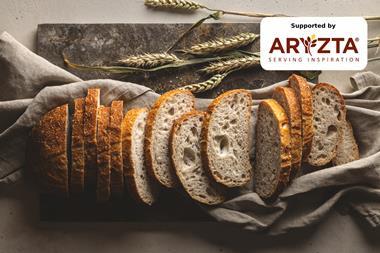Retail sales of thins are in decline as consumers switch to other products with more interesting NPD. So how can the sector maintain a commanding share of the bakery market?
There was a time when thins were the best thing since, well, sliced bread. But today, when it comes to retail sales, they are looking a little stale.
Following a few years of explosive growth – with retail sales soaring 50% between March 2014 and 2015 - sales of bread thins have slipped into reverse. More than £20m has been stripped off retail sales in the past year – a decline of 20.4% - according to Kantar Worldpanel data (52w/e 26 March 2017).
Industry observers suggest the category has lacked innovation and lost ground to newer products.
“Thins enjoyed strong year-on-year growth since inception as they offered a more convenient and innovative sandwich solution,” says Kantar Worldpanel analyst Katie Bowden. “However, there is now evidence people are switching to other formats such as bagel thins as similar categories continue to innovate.”
It’s a view echoed by Mike Roberts, deputy chairman of Frank Roberts & Sons: “The breadth of bakery products, combined with a slowdown in product development, means sandwich thins have become a less attractive offering to consumers.
Roberts adds that shoppers have switched to product sub-categories that have seen more recent NPD such as in-store bakery, bagels and bagel thins and crumpets. Warburtons reports that sales of its Thin Bagels range, launched in 2015, have grown almost 60% over the past 12 months.
“Many consumers are also returning to wrapped bread due to quality improvements and more interesting NPD within the category,” suggests Roberts.
Consumers are also switching to cheaper thins, suggests Kantar Worldpanel data. Branded products account for more than 80% of thins sales, but have lost grown to own-label thins. Aldi and Lidl have both doubled their market share in thins and have enjoyed double-digit growth in their own-label thins.
It’s a trend that may continue in this time of Brexit and economic uncertainty, says Bowden.
“It is possible price inflation may start to creep into the thins, wraps and pitta bread category,” she adds. “Incomes may also start to be squeezed, and brands may have to work harder to prevent consumers looking to cheaper ranges.”
Thins aren’t falling out of favour with Brits, insists Zoe Taphouse, category director at Kingsmill owner Allied Bakeries.
“In the last year, the bread thins category has reached a natural point in its product lifecycle and is somewhere between growth and maturity,” she says. “Despite a slowdown in category growth, thins has become a huge category, with 29% household penetration, in just four years.”
While having a loyal customer base, awareness levels for thin are nonetheless some of the lowest in the bakery market, adds Taphouse
“To achieve stronger growth, we need to generate more ‘light buyers’ by demonstrating that thins are a delicious alternative to bread,” she says.
One way of achieving this, Taphouse suggests, is giving thins more prominence in stores.
“Off-shelf space is key to this, and – with bread deflation in the marketplace – thins need to be perceived as relevant and value for money,” she says, adding that NPD is important to drive the category forward.
This could include different flavours or new market positioning - such as the Protein Thins recently launched by Warburtons - to encourage new consumers to buy.
Speaking to British Baker earlier this year, a Warburtons spokesman said: “Shoppers are constantly looking for newness and innovation, so thins growth may not always be constant or exponential,” Warburtons added at the time that increased competition in the thins market had brought some duplication and a lack of retail standout in the category.
Encouraging new uses for thins could also drive sales suggests Allied’s Taphouse: “We can inspire consumers to think more creatively about using thins, such as for pizza bases or soldiers for dipping, to create opportunities in the market.”
Roberts says good NPD should always be able to add value to a category but warns that “there are now so many options within the bread alternatives category - which continues to grow as a whole - that it will be difficult for sandwich thins to attract new buyers and retain current consumers.”
Among these other options are products such as the New York Bakery Co bagel thins that were last month relaunched with an improved recipe and an extended life of 10 days, which the company said would “fit in with the busy lifestyles and dining habits of younger, smaller household consumer groups”.
At the time of the relaunch, Amy Page, head of marketing at New York Bakery Co, said: “Shoppers told us they would buy more bakery items if they were lighter and smaller portions, offering fewer but better carbohydrates, with added benefits such as being a source of fibre.”
Health will continue to be an important focus in the coming year, according to Kantar Worldpanel’s Bowden, who says the category will need to be wary of shoppers looking to cut down on their intake of bread products.
“Bagel Thins respond effectively to this challenge by reducing portion size,” she adds. “Other products such as Hovis Best of Both Sandwich Thins or Warburtons added-protein thins tap into this health-conscious consumer and consequently perform well. Along a similar vein, free-from is a trend that looks set to continue.”
This consumer demand for “healthy indulgence” – and the prominent retail trend of premiumisation – is driving growth in alternative styles of thins, says Roberts.
“An increasing number of consumers are demanding smaller portions of their favourite treats rather than cutting them out entirely. Meeting the need, bakery thins enable them to control their calorie intake without compromising on quality and taste,” he adds.
“When given the option of bread or a bagel thin, the latter is the winner in terms of taste and perceived quality. When the trend was simply ‘health,’ sandwich thins performed well due to their reduced calories compared to sliced bread. However, with the emerging trend for premiumisation consumers are looking for more than just a thin bread. They want to indulge in a delicious lighter bite.”
Allied Bakeries’ Taphouse agrees that thins give consumers a way to manage their portion sizes, without compromising on taste.
“It is therefore no surprise that the concept is working well in other categories, which are making sensible line extensions to generate volume,” he says, adding that sales of Allied’s Kingsmill crumpet thins are up 7% over the past year.
Another opportunity for growing sales of thins is the relatively untapped foodservice market.
To date, a limited number of businesses have entered this category, with Kara, the foodservice brand of the Finsbury Food Group, last year expanding its speciality bread range with the launch of sandwich thins.
Roberts Bakery recently launched thins into foodservice and found demand is already high for its range, which comprises wholemeal and white Thin Rounds, white Skinny Thin Rounds and white Skinny Thin Slices. With a calorie content starting at 120, they can tap the trend for healthier eating, said the manufacturer.
“A significant proportion of our business is within the foodservice sector,” says Roberts. “This makes us particularly well placed to take advantage of its growth when, this year alone, Britons are forecast to spend an estimated £54.7billion on eating out - making 11.5billion visits to restaurants, pubs and other out-of-home catering outlets.
“We are developing further similar ranges to maximise the increasing out-of-home sales opportunities. “
Such comments suggest that, while bread thins have lost ground in the nation’s supermarket, there are opportunities out them to take a slice of other markets.
Toasties pocket a big share of pittas
Pitta bread has been the star performer of the thins, wraps and pitta market, according to Kantar Worldpanel. And that’s thanks to one product – Warburtons’ Toastie Pockets.
Rolled out in January this year, the bread pockets are designed to be filled before being cooked in the toaster. Available in both white and brown variants, and with four Toastie Pockets in each pack, they carry a recommended retail price of £1.20.
“Brits have always loved their sandwich toasties but, with lifestyles getting busier than ever, demand for quick and convenient meal solutions has never been so great,” said Warburtons innovation director Darren Littler at the time of the launch. “We want to make everyone’s favourite sandwich toasties more convenient for everyone to enjoy.”
It appears Warburtons has achieved this, with the products clocking up £5m in sales in their first few months on shelf according to Kantar Worldpanel. With the analysts treating the products as part of the ‘pitta’ category, Toasties have driven an 11% increase in value sales of the market. Take them out of the equation, however, and there is a slight decline in the category.
“Pitta bread also is predominantly own-label (70.7%), although this has decreased from the previous year (80.3%) as a result of the release of Warburtons Toastie Pockets, which have driven significant growth within branded pitta bread,” says Kantar Worldpanel analyst Katie Bowden. “Beyond Toastie Pockets, branded pitta bread generally doesn’t perform very well. The exceptions to this are Genius with its gluten-free offering, and smaller Brands Dina and Michael’s.”
Wraps tap lighter trends
Wraps account for just under half of retail spend in the thins, wraps & pitta market.
Volume sales have been static year on year, although super market competition has pushed down average prices and brought a 2.9% year on year drop in value sales.
Own-label accounts for 55% of the wraps category at retail, and own-label sales have grown 1.3% year on year while branded sales have fallen 1.5%.
“This is indicative of wider grocery trends that have seen retailers keen to grow and establish their private-label offering,” says Kantar Worldpanel analyst Katie Bowden.
Wraps are well placed to tap consumer demand for lighter alternatives to sliced bread, suggests David Laurence, commercial director at Signature Flatbreads.
“Now firmly established as a consumer favourite, the popularity of wraps shows no signs of waning, with consumers using them in a range of ways, from breakfast wraps to burritos, in reflection of what is being seen on menus on the high street.”
Signature Flatbreads is aiming to create new lunchtime sales opportunities for retailers with its Deli Kitchen range of “first to market, healthy, versatile and convenient sandwich carriers”.
“The new Deli Kitchen range is full of concepts that offer low-calorie, high-fibre and high-protein sandwich carriers, as well as a unique shape that offers ease of use,” says Laurence. “We fully expect the range will drive significant growth in the alternative sandwich carrier category.”
Also looking to tap demand for healthier products is Tex-Mex wholesaler and distributor Funnybones Foodservice, which says interest is growing in corn-based wraps.
“With the growing pressure to make lighter choices Funnybones Foodservice has gone back to the home of tortillas to source authentic wraps made to traditional recipes from corn rather than wheat,” says Tom Styman-Heighton, Funnybones Foodservice development chef.
Funnybones has this year launched two new tortillas made by made by Blanco Nino from blue corn (also known as purple corn), which it says contains less starch, has 20% more protein and has a lower glycemic index than white corn.
“Blue corn is ground into flour in a traditional way which enhances its sweet, nutty taste and makes for very delicious and nutritious tortillas and chips,” says Styman-Heighton.
The new line-up comprises a 15cm Soft Blue Corn Tortillas to be warmed on the grill; and a 15cm Frying Blue Corn Tortillas that needs frying for 20-30 seconds to bring out its flavours.
Meanwhile, Nina Bakery – best known for its pitta breads – has recently launched the wrap-style laff flatbread. Laffa, which is sometimes known as Iraki Pita, originates in the Middle East.
“From a centuries-old tradition, laffa has been eaten with salads,” says Nina Bakery sales manager Marlies Wolters. “Beside this option you can use laffa for topping or filling and wrapping with meat, vegetables and even sweet fillings. Top the laffa with houmous or falafel, roll and serve as a delicacy from the Middle East.”
That’s a wrap: wooing lunch break consumers
Health is a big focus for consumers when it comes to shopping for a lunchtime wrap.
Some 14% of lunchtime shoppers select a retailer for its healthy food options, with Pret A Manger over-indexing strongly with health-conscious wrap buyers, according to Sandwich & Bakery Tracker research published by foodservice experts MCA.
Wraps are the top savoury bakery choice for 12.7% of workers on their lunch breaks, found MCA.
While this is less than products including subs (16%), sandwiches (15.6%) and pasties (13.2%), this means wraps are a more popular choice than bakery stalwarts including sausage rolls (11.6%), toasted sandwiches (7.1%) and pizza (4.9%).
Wraps drop down the list when looking at the lunchtime needs of consumers on a shopping trip, however, and are the top choice of 11.1% of shoppers. Among the more popular choices are toasted sandwiches (20.6%), savoury croissants (14.1%) and tarts (12.9%).
Researchers found shoppers had very different needs when it came to buying breakfast wraps, with low prices a key consideration.
Three in 10 breakfast wraps are bought because they are inexpensive, compared to two in 10 total savoury breakfast bakery items, according to MCA. McDonald’s dominates in this area, accounting for three-fifths of breakfast wraps bought because they are inexpensive.
MCA is launching a dedicated Sandwich & Bakery Market Tracker this month. For more information on this quarterly report contact Richard Hayman on richard.hayman@mcallegra-fs.com.


























No comments yet